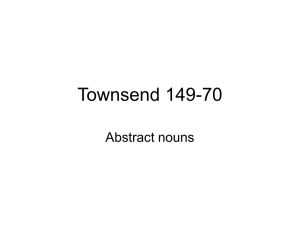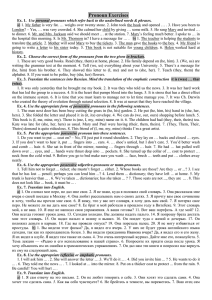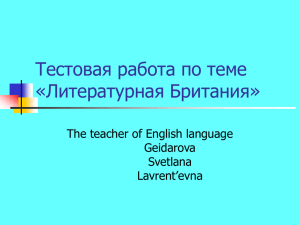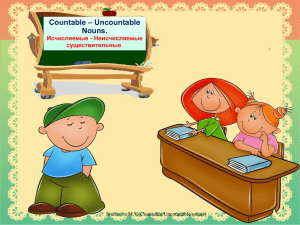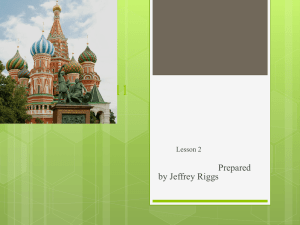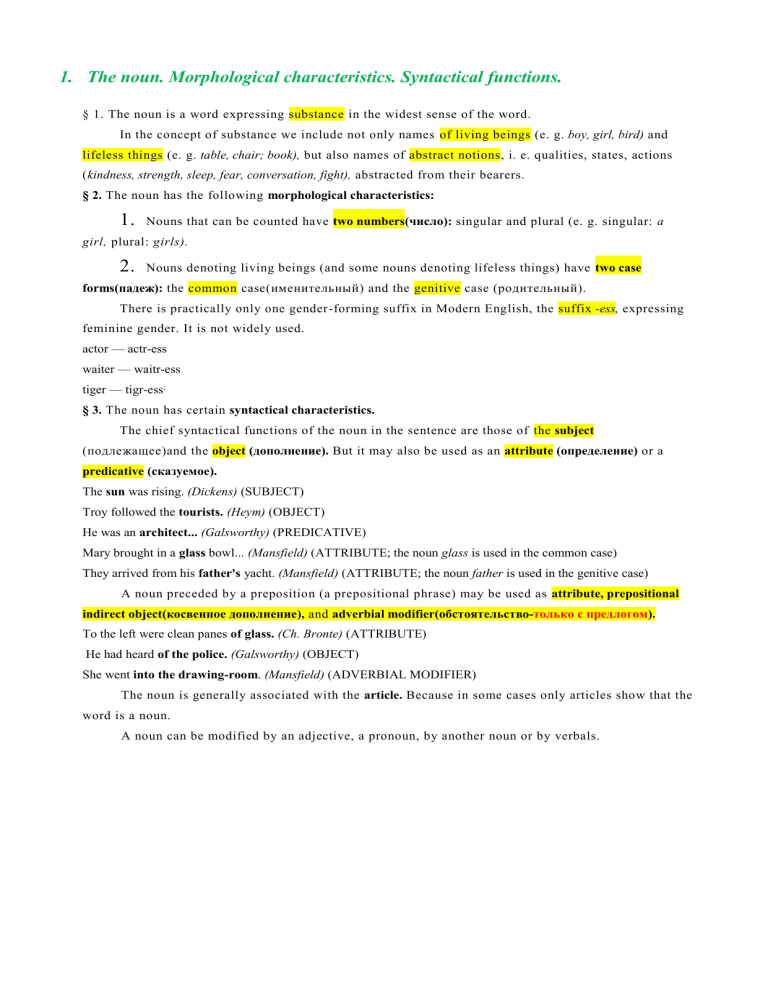
1. The noun. Morphological characteristics. Syntactical functions.
§ 1. The noun is a word expressing substance in the widest sense of the word.
In the concept of substance we include not only names of living beings (e. g. boy, girl, bird) and
lifeless things (e. g. table, chair; book), but also names of abstract notions, i. e. qualities, states, actions
(kindness, strength, sleep, fear, conversation, fight), abstracted from their bearers.
§ 2. The noun has the following morphological characteristics:
1.
Nouns that can be counted have two numbers(число): singular and plural (e. g. singular: a
girl, plural: girls).
2.
Nouns denoting living beings (and some nouns denoting lifeless things) have two case
forms(падеж): the common case(именительный) and the genitive case (родительный).
There is practically only one gender -forming suffix in Modern English, the suffix -ess, expressing
feminine gender. It is not widely used.
actor — actr-ess
waiter — waitr-ess
tiger — tigr-ess;
§ 3. The noun has certain syntactical characteristics.
The chief syntactical functions of the noun in the sentence are those of the subject
(подлежащее)and the object (дополнение). But it may also be used as an attribute (определение) or a
predicative (сказуемое).
The sun was rising. (Dickens) (SUBJECT)
Troy followed the tourists. (Heym) (OBJECT)
He was an architect... (Galsworthy) (PREDICATIVE)
Mary brought in a glass bowl... (Mansfield) (ATTRIBUTE; the noun glass is used in the common case)
They arrived from his father's yacht. (Mansfield) (ATTRIBUTE; the noun father is used in the genitive case)
A noun preceded by a preposition (a prepositional phrase) may be used as attribute, prepositional
indirect object(косвенное дополнение), and adverbial modifier(обстоятельство-только с предлогом).
To the left were clean panes of glass. (Ch. Bronte) (ATTRIBUTE)
He had heard of the police. (Galsworthy) (OBJECT)
She went into the drawing-room. (Mansfield) (ADVERBIAL MODIFIER)
The noun is generally associated with the article. Because in some cases only articles show that the
word is a noun.
A noun can be modified by an adjective, a pronoun, by another noun or by verbals.
2. The noun. Morphological compositions. Gender
§ 4. Morphological composition of nouns.
According to their morphological composition we distinguish simple(простые), derivative(производные) and
compound(составные) nouns.
1.Simple nouns are nouns which have neither prefixes nor suffixes. They are indecomposable: chair; table,
room, map, fish, work.
2.Derivative nouns are nouns which have derivative elements ( prefixes or suffixes or both): reader, sailor,
blackness, childhood, misconduct, inexperience.
Productive noun-forming suffixes are:
Unproductive suffixes are:
-er: reader, teacher,
-hood: childhood, manhood
-ist: communist, telegraphist,
-dom: freedom
-ism: socialism, nationalism,
-ship: friendship, relationship
-ess: hostess, actress
-ment: development
-ness: madness, blackness
-ance: importance
-ence: dependence
-ty: cruelty
-ity: generosity
3.Compound nouns are nouns built from two or more stems. Compound nouns often have one stress. The
meaning of a compound often differs from the meanings of its elements.
The main types of compound nouns are as follows:
а) noun-stem + noun-stem: appletree, snowball;
b)adjective-stem + noun-stem: blackbird, bluebell;
c)verb-stem + noun-stem: pickpocket;
the stem of a gerund or of a participle may be the first component of a compound noun: dining- room, readinghall, dancing-girl.
The class of compound nouns also includes phrasal compounds: forget-me-not, commander-in-chief
1
Gender is the distinction of nouns into masculine, feminine and neuter, may be expressed
lexically by means of different words or word-compounds:
boy — girl
man — woman
cock-sparrow — hen-sparrow
man-servant — maid-servant
Very often personal or possessive pronouns indicate the gender of the noun.
There is practically only one gender -forming suffix in Modern English, the suffix -ess,
expressing feminine gender. It is not widely used.
actor — actr-ess
waiter — waitr-ess
tiger — tigr-ess;
3. The noun. Classification
§ 5. Classification of nouns.
Nouns fall under two classes: (A) proper nouns(имена собственные); (B) common
nouns(нарицательные). 1
A.Proper nouns are individual names given to people or things. As regards their meaning proper
nouns may be personal names {Mary, Peter;), geographical names (Moscow, London), the names of the
months and of the days of the week (February, Monday), names of ships, hotels, clubs etc.
A large number of nouns now proper were originally common nouns (Brown, Smith).
Proper nouns may change their meaning and become common nouns:
George took a sandwich and a glass of champagne. (Aldington)
B. Common nouns are names that can be applied to any individual of a class of people or things (e.g.
man, dog), collections of similar individuals or things regarded as a single unit (e. g. peasantry, family),
materials Ґ (e. g. snow, iron,) or abstract notions (e. g. kindness, development).
Thus there are different groups of common nouns: class(предметные) nouns,
collective(собирательные) nouns, nouns of material(обозначающие материю) and abstract(абстрактные)
nouns.
Nouns may also be classified from another point of view: nouns denoting things that can be counted
are called countable nouns; nouns denoting things that cannot be counted are called uncountable nouns.
1.
Class nouns denote people or things belonging to a class. They are countable and have two numbers:
singular and plural. They are generally used with an article. 1
"I wasn't in the shop above a great deal." (Mansfield)
Where are the shops in this town?. (Lessing)
2.
Collective nouns denote a number or collection of similar individuals or things regarded as a single unit.
Collective nouns fall into the following groups:
1. nouns used only in the singular and denoting a number of things collected together and regarded as
a single object: foliage(листва), machinery(механизм).
It was not restful, that green foliage. (London)
2.
nouns which are singular in form though plural in meaning: police, poultry(мясо птицы),
cattle(скотина), people, gentry(дворянство). They are usually called nouns of multitude. When the subject of
the sentence is a noun of multitude the verb used as predicate is in the plural:
The people were sitting at their doors. (Dickens)
3.
nouns that may be both singular and plural: family, crowd, government, staff\ team, audience,
committee, fleet, nation.
A small crowd is lined up. (Shaw)
A whole crowd of us are going to the ball.
There are three nouns ending in – s that can also be singular or plural:
Means(средство/ва)
Series(серия/рии)
Species(вид/ды)
a means of traffic
a television series
a species of bird
many means of traffic
two television series
200 species of bird
3.
Nouns of material denote material: iron, gold.
They are uncountable and are generally used without any article. 1
There was coffee still in the urn. (Wells)
Nouns of material are used in the plural to denote different sorts of a given material.
There are many wines on the table.
Nouns of material may turn into class nouns (thus becoming countables) when they come to
express an individual object of definite shape.
To the left were clean panes of glass. (Ch. Bronte)
But the person in the glass made a face at her. (Mansfield)
4. Abstract nouns denote some quality, state, action or idea: kindness, sadness, fight. They are
usually uncountables, though some of them may be countables (e. g. idea, hour)
I never had an idea of replying to it. (Ch. Bronte) It's these people with fixed ideas. (Galsworthy)
Abstract nouns may change their meaning and become class nouns. This change is marked by
the use of the article and of the plural number: (Beauty,a beauty,beauties; a sight, sight, sights)
He was responsive to beauty.
She was a beauty. (Dickens)
she isn't one of those horrid regular beauties. (Aldington)
4. The noun. The category of number.
§ 6. The category of number.
English countable nouns have two numbers — the singular and the plural.
The main types of the plural forms of English nouns are as follows:
1.
1. The general rule for forming the plural of English nouns is by adding the ending (-es) to the singular; -s is
pronounced in different ways:
[iz] after sibilants: noses, horses, bridges.
[z] after voiced consonants other than sibilants and after vowels: flowers, beds, doves, bees, boys.
[s] after voiceless consonants other than sibilants: caps, books, hats, cliffs.
2.
If the noun ends in -s, -ss, -x, -sh, -ch, or -tchf the plural is formed by adding -es to the singular:
bus — buses
1
brush — brushes
glass — glasses
box — boxes
bench — benches
match — matches
On the use of articles with abstract nouns see Chapter II, § 8, 9, 10
3. If the noun ends in -y preceded by a consonant, y is changed into i before -es.
fly — flies
army — armies
lady — ladies
In proper names, however, the plural is formed by adding the ending to the singular: Mary,
Marys.
N o t e. If the final -y is preceded by a vowel the plural is formed by simply adding -5 to the singular.
day — days
monkey — monkeys
play — plays
toy — toys
key — keys
boy — boys
1.
If the noun ends in -o preceded by a consonant, the plural is generally formed by adding -es.
Only a few nouns ending in -o preceded by a consonant form the plural in -5.
cargo — cargoes
potato — potatoes
hero — heroes
echo — echoes
but:
piano — pianos solo — solos photo — photos
All nouns ending in -o preceded by a vowel form the plural in and not in -es.
cuckoo — cuckoos
portfolio — portfolios
There are a few nouns ending in -o which form the plural both in -5 and -es:
mosquito — mosquitos or mosquitoes
2.
With certain nouns the final voiceless consonants are changed into the corresponding voiced
consonants when the noun takes the plural form.
(a)
The following nouns ending in –f (in some cases followed by a mute e) change it into v (both in spelling
and pronunciation) in the plural:
wife — wives
knife — knives
life — lives
sheaf — sheaves
leaf — leaves
thief — thieves
half — halves
calf — calves
shelf — shelves
wolf — wolves
There are some nouns ending in –f which have two forms in the plural:
scarf — scarfs or scarves
wharf — wharfs or wharves
b) Nouns ending in -th [Ө] after long vowels change it into [ð] in pronunciation (which does not affect their
spelling).
bath [ba:Ө] — baths [ba:ðz]
path [pa:Ө] — paths [pa:ðz] oath [əuӨ] — oaths [əuӨ z]
But [Ө] is always retained after consonants (including r) and short vowels:
smith — smiths [smiӨs] month — months [m۸nӨs] myth — myths [miӨs] birth — births
[b3:Ө] health — healths [helӨs]
c) One noun ending in [s] changes it into [z] (in pronunciation):
house [haus] — houses ['hauziz]
II. The plural forms of some nouns are survivals of earlier forma tions.
1. There are seven nouns which form the plural by changing the root vowel:
man — men
woman — women
foot — feet
tooth — teeth
goose — geese
mouse — mice
louse — lice
2. There are two nouns which form the plural in -en:
ox — oxen
child — children
N o t e . The noun brother has, beside its usual plural form brothers, another plural form brethren, which is
hardly ever used in colloquial language. It belongs to the elevated style and denotes people of the same
creed and not relationship.
The noun cow has, beside its usual plural form cows, a plural kine, which sometimes occurs in poetry.
3. In some nouns the plural form does not differ from the singular: deer, sheep, swine, fishy trout.
III.Some words borrowed from Latin or Greek keep their Latin or Greek plural forms: e. g. phenomenon,
phenomena; datum, data; crisis, crises; stimulus, stimuli; formula, formulae; index, indices. Some of these nouns have
acquired English plural forms: memorandums, formulas, indexes, terminuses, etc.
The tendency to use the foreign plural is still strong in the technical language of science, but
in fiction and colloquial English there is an evident inclination to give to certain words the regular
English plural forms in -5. Thus in some cases two plural forms are preserved ( formulae, formulas;
antennae, antennas).
IV. In compound nouns the plural is formed in different ways.
1. In compound nouns the final element takes the plural form:
lady-bird — lady-birds
2.As a rule a phrasal compound noun forms the plural by adding -s to the head-word:
editor-in-chief — editors-in-chief
brother-in-law — brothers-in-law
looker-on — lookers-on
3.If there is no noun-stem in the phrasal compound, is added to the last element:
forget-me-not — forget-me-nots
merry-go-round — merry-go-rounds
V. Some nouns have only the plural form:
1. Trousers, spectacles, breeches, scissors, tongs, fetters. These are for the most part names of things which imply
plurality or consist of two or more parts.
2.Billiards, barracks, works. These nouns may be treated as singu lars. We may say: a chemical works, a barracks,
etc.
3.Words like phonetics, physics, politics, optics, etc. are usually treated as singulars except in some special
cases.
It was not practical politics! (Galsworthy)
All party politics are top dressing. (Galsworthy)
4.The word news is treated as a singular.
When she goes to make little purchases, there is no news for her. (Thackeray)
The news he gave them was to be read in the lamentations. (Sabatini)
N o t e . The names of sports teams are normally used with the verb in the plural form:
Scotland are playing France in a football match next week.
5. The noun. The category of case. Absolute genitive
§ 7. The category of case.
Case(падеж) indicates the relations of the noun to the other words in the sentence.
English nouns denoting living beings (and some nouns denoting lifeless things) have two cases, an uninflected form
called the common case(именительный) and an inflected form called the genitive(родительный) case.
1. The genitive case is formed by adding – ‘s (the apostrophe s) to the noun in the singular and only ' (the apostrophe) to
plural forms ending in -s.
SINGULAR: girl's books
PLURAL: girls' books
N o t e 1. Nouns forming their plural by changing the root vowel take the apostrophe s in the plural.
SINGULAR: a man's hat
PLURAL: men's hats
N o t e 2. Nouns ending in -s form the genitive case in two ways: Dickens' novels, Dickens's novels.
The pronunciation of the genitive case ending follows the same rules as the pronunciation of the plural
ending:
[iz] after sibilants: prince's, Judge's,
[z] after voiced consonants other than sibilants and after vowels: boy's, man's,
[s] after voiceless consonants other than sibilants: Smith's, count's,
N o t e . With nouns ending in -s and forming the genitive case in two ways the ending is pronounced [iz]
whether the letter s is written or not.
2.Sometimes the apostrophe s may refer to a whole group of words (the group-genitive): Jane and Mary's
room. The last word of the group need not even be a noun: I shall be back in an hour or two's time.
The genitive case falls under:
(A)The Dependent Genitive.
(B)The Absolute Genitive.
The Dependent Genitive is used with the noun it modifies and comes before it.
The Absolute Genitive may be used without any noun or be separated from the noun it modifies.
B. The Absolute Genitive.
1.
The Absolute Genitive may be used anaphorically.
Mrs. Moss's face bore a faded resemblance to her brother's. (Eliot)
2.
The Absolute Genitive may have local meaning: the stationer's, the baker's,
She usually buy a slice of honey-cake at the baker's. (Mansfield)
The Absolute Genitive may be introduced by the preposition of.
She is a relation of the Colonel's. (Austen)
6. The noun. The category of case. Dependent genitive
A. The Dependent Genitive.
1.
The chief meaning of the genitive case is that of possession:
He stayed at Fanny's flat. (Aldington)
2.
Very close to the meaning of possession is that of a part to a whole:
His sister's eyes fixed on him. (Galsworthy)
3.
The Dependent Genitive may express the doer of an action (the so-called subjective genitive) or show that
some person is the object of the action (the so-called objective genitive):
It was Tom's step.
The noun in the genitive case may denote qualitative relations:
He looked smarter in his new officer's clothes. (Aldington)
The use of the genitive case of nouns denoting inanimate things and abstract notions is rather limited but it
may denote the relations between a part and the whole.
He stepped on the truck's running board. (Heym)
The genitive case of nouns expressing time, space and weight is widely used.
He was sent to the officers' training camp with two days' leave. (Aldington)
I walked down past the theatre to the river's edge. (Snow)
7. The adjective
§ 1. The adjective is a word expressing a quality(качество) of a substance.
§ 2. The adjective has the following morphological characteristics:
Most adjectives have degrees of comparison: the comparative degree and the superlative degree. 1
The comparative degree denotes a higher degree of a quality.
She is taller than her sister.
The superlative degree denotes the highest degree of a quality.
She is the tallest of the three sisters.
Adjectives form their degrees of comparison in the following way:
(a)by the inflexion -er, -est (synthetical way); - Monosyllabic adjectives
(b)by placing more and most before the adjective (analytical way). – polysyllabic
The following polysyllabic adjective, generally form their comparative and superlative degrees
inflexionally:
1. Adjectives of two syllables which end in -y, -ow, -er; -le.
happy
happier
(the) happiest
narrow
narrower
(the) narrowest
clever
cleverer
(the) cleverest
simple
simpler
(the) simplest
2. Adjectives of two syllables which have the stress on the last syllable:
complete
completer
(the) completest
Some adjectives have irregular forms of degrees of comparison, e.g.:
good
better
(the) best
bad
worse
(the) worst
many, much
more
(the) most
little
less
(the) least
far
farther
(the)
further
the furthest
old
older
farthest
the oldest
(the)
elder
eldest
§ 3. Spelling rules.
1.
If the adjective ends in a consonant preceded by a stressed short vowel the consonant is doubled before -er,
-est.
sad
2.
(the) saddest
If the adjective ends in -y preceded by a consonant, y is changed into i before -er and -est.
happy
3.
sadder
happier
(the) happiest
If the adjective ends in -e the e is dropped before -er and -est.
brave
braver
(the) bravest
§ 4. The adjective has the following syntactical characteristics:
In a sentence the adjective may be used as an attribute or as a Predicative.
A little fat chap thrust out his underlip. (Mansfield) (ATTRIBUTES)
Laura was terribly nervous. (Mansfield) (PREDICATIVE)
§ 5. Morphological composition of the adjective.
Adjectives are divided into simple, derivative and compound.
1.
Simple adjectives are adjectives which have neither prefixes nor suffixes. They are indecomposable: e.
g. good, red, black.
2.
Derivative adjectives are adjectives which have derivative elements, suffixes or prefixes or both:
beautiful, foolish, hopeless.
Productive adjective-forming suffixes
Unproductive suffixes are:
are:
-ful: careful
-less: friendless,
-ent: dependent
-like: childlike
-ible: responsible
-ish: childish,
-en: woolen
-ed (-d): beaded
-ous: dangerous
-some: troublesome
Productive adjective-forming prefixes
The unproductive prefixes of the adjective are:
are:
in-: incorrect
un-: unhappy
ir-: irregular
pre-: prewar
im-:improper
3. Compound adjectives are adjectives built from two or more stems.
The main types of compound adjectives are as follows:
1.
2.
3.
4.
5.
6.
7.
noun-stem + adjective-stem: snow-white.
noun-stem + participle-stem: life-giving.
adjective-stem + adjective-stem: deaf-mute.
adjective-stem + noun-stem + suffix -ed: cold-hearted.
noun-stem + noun-stem + suffix -ed: lynx-eyed.
numeral-stem + noun-stem + suffix -ed: four-wheeled.
adverb-stem + noun-stem + suffix -ed: over-peopled.
8. The adjective
§ 6. Classification of adjectives.
According to their meaning and grammatical characteristics adjectives fall under two classes: ( 1 )
qualitative adjectives, (2) relative adjectives.
1.
Qualitative adjectives denote qualities of a substance directly, not through its relation to another substance,
as size, shape, colour, physical and mental qualities, qualities of general estimation:
little, high, soft, important, etc.
2.
Relative adjectives denote qualities of a substance through their relation to materials (silken, woollen, wooden),
to place (Italian, Asian), to time (monthly, weekly), to some action (preparatory, rotatory).
§ 7. Grammatical characteristics of qualitative adjectives.
1. Most qualitative adjectives have degrees of comparison:
big
bigger
interesting
more interesting
(the) biggest
(the) most interesting
Some qualitative adjectives such as greenish, darkish, incurable, unsuitable, chief, principal, have no
degrees of comparison.
2.They have certain typical suffixes, such as -ful, -less, -ous, -ent, -able, -y, -ish: careful, careless,
dangerous, convenient, comfortable, silvery, shortish.
3.From most of them adverbs can be formed by the suffix -ly:
graceful — gracefully
4.Most qualitative adjectives can be used as attributes and predicatives.
The young man was introduced to us. (Aldington) (ATTRIBUTE)
But you're nearly as old as I am! (Aldington) (PREDICATIVE)
§ 8. Grammatical characteristics of relative adjectives.
1.
Relative adjectives have no degrees of comparison.
2.
They do not form adverbs with the suffix -ly. But if they develop a figurative meaning, adverbs
can be formed.
wooden — 1) made of wood; 2) not showing enough natural expres sion, emotion or movement.
She speaks her lines rather woodenly.
3.
They have certain typical suffixes, such as -en, -an, -ist, -ic, -ical: wooden, Italian, socialist, synthetic,
analytical.
4.
Relative adjectives are mainly used as attributes.
... she is a good example of the middle American class... (Dreiser) (ATTRIBUTE)
The morning was windy. (Saxton) (PREDICATIVE)
§ 9. Substantivized adjectives.
Substantivized adjectives have acquired some or all of the characteristics of the noun, but their
adjectival origin is still generally felt.
Substantivized adjectives are divided into wholly substantivized and partially substantivized
adjectives.
Wholly substantivized adjectives have all the characteristics of nouns, namely the plural form, the
genitive case; they are associated with articles, i. e. they have become nouns: a native, the natives, a native's
hut.
Some wholly substantivized adjectives have only the plural form: eatables, valuables, ancients, sweets,
greens(зелень).
Partially substantivized adjectives acquire only some of the characteristics of the noun; they are used
with the definite article. Partially substantivized adjectives denote a whole class: the rich, the poor; the
unemployed. They may also denote abstract notions: the good, the evil, the present, the past.
Substantivized adjectives denoting nationalities fall under wholly and partially substantivized
adjectives.
Wholly substantivized adjectives are: a Russian — Russians, a German — Germans.
Partially substantivized adjectives are: the English, the French, the Chinese.
9. The adverb - наречие
§ 1. The adverb is a part of speech which expresses some circumstances that attend an action or state, or points out some
characteristic features of an action or a quality.
The function of the adverb is that of an adverbial modifier. An adverb may modify verbs (verbals), words of the
category of state, adjectives, and adverbs.
For a second they stood with hands hard clasped. (Galsworthy)
He spoke quite kindly and sensibly about it. (Jerome)
§ 2. Adverbs are divided into:
(1)simple adverbs (long, enough, etc.);
(2)derivative adverbs (slowly, forward etc.); (The most productive adverb-forming suffix is -ly. There are also some other
suffixes: -long, -wards, -ward; -wise.)
(3)compound adverbs ( sometimes, nowhere, etc.);
(4)composite adverbs ( a t once, at last, etc.).
§ 3. Some adverbs have degrees of comparison.
(a)If the adverb is a word of one syllable, the comparative degree 's formed by adding -er and the superlative by adding est.
fast — faster — fastest
(b)Adverbs ending in -ly form the comparative by means of more and the superlative by means of most.
beautifully — more beautifully — most beautifully
(c)Some adverbs have irregular forms of comparison:
well — better — best
badly — worse — worst
much — more — most
little — less — least
§ 4. According to their meaning adverbs fall under several groups:
(1)adverbs of time (today, tomorrow, etc.);
(2)adverbs of repetition or frequency (often, seldom, sometimes, etc.);
(3)adverbs of place and direction (inside, outside, etc.);
(4)adverbs of cause and consequence (therefore, consequently, etc.);
(5)adverbs of manner (kindly, quickly, hard, etc.);
(6)adverbs of degree, measure and quantity ( enough, half, twice, secondly, etc.).
Three groups of adverbs stand aside: interrogative, relative and conjunctive adverbs.
Interrogative adverbs (where, when, why, h o w ) are used in special questions.
Conjunctive and relative adverbs are used to introduce subordinate clauses.1
Some adverbs are homonymous with nouns, adjectives, prepositions, conjunctions2, words of the category of state3 and
modal words4.
10. The modal words
§ 1. The modal words express the attitude of the speaker to the reality, possibility or probability of the action he speaks
about.( отношение говорящего к действительности, возможности или вероятности того действия, о котором он
говорит.)
§ 2. According to their meaning modal words fall under the following main groups:
(1)words expressing certainty(уверенность) (certainly, surely, assuredly, of course, no doubt, apparently, undoubtedly,
etc.);
(2)words expressing supposition(предположение) (perhaps, maybe, possibly, probably, etc.);
(3)words showing whether the speaker considers the action he speaks about desirable or
undesirable(желательное/нежелательное) (happily — unhappily; luckily — unluckily ;fortunately — unfortunately).
§ 3. In the sentence modal words are used as parentheses.1 Sometimes they are used as sentence-words.2
Certainly we could finish all this in a month. (Wilson)
"Will you allow me to detain you," said he. "Certainly," replied the visitor. (Dickens)
§ 4. Most modal words have developed from adverbs. For instance such modal words as certainly, surely, happily are
homonymous with the adverbs certainly, surely, happily. Though formally identical with adverbs, modal words differ
from them in meaning and syntactical function.
Slowly, surely, the poison had corroded edifice of his philosophy. (Galsworthy) (ADVERB)
Surely she would find him over the ridge. (Wells) (MODAL WORD)
11. The interjection - междометие
§ 1. The interjection is a part of speech which expresses various emotions without naming them.
§ 2. According to their meaning interjections fall under two main groups, namely emotional interjections and
imperative interjections.
1. Emotional interjections express the feelings of the speaker. They are: ah, oh, eh, bravo, alas, etc.
"Dear me!" says Mr. Chillip . (Dickens) (surprise)
2. Imperative interjections show the will of the speaker or his order or appeal to the hearer. They are: here, hush, sh-sh,
well, come, now, etc.
Here! I've had enough of this. (Shaw) (protest)
§ 3. Interjections may be primary and secondary.
1. Primary inteijections are not derived from other parts of speech. Most of them are simple words: ah, oh, e h f
pooh, hum, fie, bravo, hush. Only a few primary interjections are composite: heigh-ho! hey-ho! holla-ho! gee-ho!
2. Secondary interjections are derived from other parts of speech
They are homonymous with the words they are derived from. They are: well, now, here, there, come, why, etc.
Derivative interjections may be simple: well, here, there, come, etc. and composite: dear me, confound it, hang it,
etc.
(Derivative interjections should not be confused with exclamation- words, such as nonsense, shame, good, etc.)
Interjections are used as independent sentence-words or independent elements of the sentence.1
Well, I don't like mysterious little pleasure trips. (Voynich)
12. The pronoun
§ 1. The p ro no u n is a part of speech which points out objects and their qualities without naming them.
§ 2. Classification of pronouns.
Pronouns fall under the following groups:
1.
personal pronouns: I, he, she, it, we, you, they
2.
3.
4.
5.
6.
7.
8.
9.
possessive pronouns: my, his, her, its, our, your, their; mine, his, hers, ours, yours, theirs.
reflexive pronouns: myself, himself, herself, itself, ourselves, yourself (yourselves), themselves.
reciprocal pronouns: each other, one another.
demonstrative pronouns: this (these), that (those), such, (the) same.
interrogative pronouns: who, whose, what, which.
relative pronouns: who, whose, which, that, as.
conjunctive pronouns: who, whose, which, what.
defining pronouns: each, every, everybody, everyone, everything, all, either, both, other,
another.
10.
indefinite pronouns: some, any, somebody, anybody, something, anything, someone, anyone,
11.
negative pronouns: no, none, neither, nobody, no one, nothing.
one.
There is no uniformity of morphological and syntactical characteristics in the groups of
pronouns. Some pronouns have the grammatical categories of person, gender, case, and number. The
categories of Person and gender (in the third person singular) exist only in personal and possessive
pronouns.
Pronouns as well as nouns have two cases but whereas some pronouns (e. g. personal pronouns
and the relative and interrogative who) have the nominative (another term is 'subjective') and objective
cases, others (e. g. indefinite pronouns such as somebody, reciprocal pronouns such as one another,
negative pronouns such as nobody) have the common and genitive cases.
The category of number is found in demonstrative pronouns (this and that) and the defining
pronoun other.
Many pronouns are characterised by double syntactical use (they may be used as subject,
predicative, object, and at the same time as attribute). Here belong demonstrative pronouns,
possessive pronouns, etc.
§ 3. Personal pronouns. - личные
1. The personal pronouns are: I, he, she, it, we, you, they. The personal pronouns have the
grammatical categories of person, case, number and (in the third person singular) gender.
The personal pronouns have two cases: the nominative case and the objective case.
The nominative case: I, he, she, it, we, you, they.1
The objective case: me, him, her, it, us, you, them.2
The objective case of the pronouns I, he, she, we is expressed by suppletive forms.
In colloquial speech me, not I is commonly used as a predicative: Who is there ? — It is me.
The personal pronouns have two numbers, singular (I, he, she, it) and plural (we, they).
The second-person pronoun you is both singular and plural.
The pronouns of the third person he, she, it distinguish gender. Male beings {man, father, uncle,
boy, etc.) are referred to as he; female beings {woman, mother, aunt, girl, etc.) are referred to as she;
inanimate things {house, tree, cap, etc.) are referred to as it.3
She gave me a pan.
1.The archaic pronoun of the second person singular is thou.
2.The objective case of thou is thee.
3.In literary style the general principle is to associate with the pronoun he words indicating strong forces,
violent passions, violent actions, big heavenly bodi es (wind, fear, love, anger; despair, sun); and to
associate with the pronoun she gentler forces, gentler feelings, smaller heavenly bodies (hope, mercy,
justice, modesty, moon).
As some nouns denote animate beings of either sex, masculine or feminine {friend, teacher; servant,
cousin etc.), personal pronouns are often used to specify them:
"Tell your servant that he must not use such words to Hendrike, Mr. Allan," Stella said to me. (Haggard)
2. Personal pronouns may have different functions in the sentence, those of subject, object,
predicative:
I was not free to resume the interrupted chain of my reflections till bed-time... (Ch. Bronte) (SUBJECT)
He arranged to meet her at the 96th Street station... (Wilson) (OBJECT)
"Who's there?" "It's me." (PREDICATIVE)
§ 4. Possessive pronouns. - притяжательные
Possessive pronouns have the same distinctions of person, number, and gender as personal pronouns.
Possessive pronouns have two forms, namely the dependent (or conjoint) form and the independent
(or absolute) form.
Conjoint forms of possessive pronouns
1st person
2nd person
3rd person
SINGULAR
my
your1
his, her, its
PLURAL
our
your
their
1st person
2nd person
3rd person
SINGULAR
mine
yours
his, hers2
PLURAL
ours
yours
theirs
Absolute forms of possessive pronouns
1.The archaic pronouns of the second person singular are: thy (conjoint), thine (absolute).
2.No absolute form of the third person neuter pronoun exists.
The dependent form is used when the possessive pronoun comes before the noun it modifies.
This form of the possessive pronoun is used as an attribute.
In his turn old Jolyon looked back at his son. (Galsworthy)
The absolute form is used when the possessive pronoun does not modify any noun.
The absolute form of the possessive pronoun may be used as subject, predicative or object. The
group 'preposition + absolute form' may be used as an attribute.
"Yours (sum of money) won't come short of a hundred thousand (SUBJECT)
it's mine all right. (PREDICATIVE)
he resolved to get away from it and talk hers. (London) (OBJECT)
that was stowed away in that pretty head of hers... (London) (ATTRIBUTE)
3. Possessive pronouns are often used before the names of the parts of the body, clothing,
things belonging to a person, etc. In that case they are not translated into Russian.
He held out his hand to help his father up. — Молодой Джолион протянул руку, чтобы помочь отцу встать.
§ 5. Reflexive pronouns. - возвратные
1. Reflexive pronouns have the categories of person, number, and gender in the third person
singular.
1st person
2nd person
3rd person
SINGULAR
myself
yourself1
himself, herself, itself
PLURAL
ourselves
yourselves
themselves
1
The archaic pronoun of the second person singular is thyself.
2. Reflexive pronouns refer to the subject of the sentence in which they are used, indicating
that the action performed by the doer passes back to him or is associated with him.
In the sentence they are usually used as direct objects.
In that moment of emotion he betrayed the Forsyte in him — forgot himself (OBJECT)
Reflexive pronouns may be used as predicatives.
she was herself again. (Hardy) (PREDICATIVE)
Reflexive pronouns preceded by a preposition may be used as indirect prepositional objects, as
attributes and as adverbial modifiers.
she was competing with herself... (Dreiser) (PREPOSITIONAL INDIRECT OBJECT)
she ventured to observe, anxious to keep away from the subject of herself. (Hardy) (ATTRIBUTE)
she could have an allowance and live by herself. (Galsworthy) (ADVERBIAL MODIFIER OF MANNER)
Reflexive pronouns may be used to form the reflexive voice (in this case reflexive pronouns
are structural words):
she washed herself intensively... (Galsworthy)
In Modern English, however, reflexive pronouns are not normally used after the verbs wash,
dress, shave:
I got up, shaved, washed and dressed.
Note that they are not used after the verbs feel, relax, concentrate, meet.
I feel great after having completed this work.
What time shall we meet?
Sometimes reflexive pronouns are used emphatically:
You can do it yourself.
§ 6. Reciprocal pronouns. - взаимные
1.
Reciprocal pronouns are the group-pronouns each other and one another. They express mutual action or
relation. The subject to which they refer must always be in the plural .
We haven't set eyes on one another for years. (Priestley)
Each other generally implies only two, one another two or more than two people:
He had never heard his father speaks in an angry voice, either to each other. (Galsworthy) Seated in a row close to one
another were three ladies (Galsworthy)
It must be mentioned that this distinction is not always strictly observed :
I should have been surprised if those two could have thought very highly of one another. (Dickens)
2.
Reciprocal pronouns have two case forms.
Girls banged into each other and stamped on each other's feet. (Mansfield)
The common case of reciprocal pronouns is used as an objcct.
They found each other delightful. (Aldington)
The genitive case of reciprocal pronouns may be used as an attribute.
At first it struck me that I might live by selling my works to the ten per cent who were like myself; but a moment's
reflection showed me that these must all be as penniless as I, and that we could not live by, so to speak, taking in one
another's washing. (Shaw)
They look hopelessly into each other's face. (Dodge)
Reciprocal pronouns preceded by a preposition are used as a prepositional indirect object:
... in silence they stared at each other. (Saxton)
§ 7. Demonstrative pronouns.- указательные
1.
The demonstrative pronouns are this, that, such, (the) same. The demonstrative pronouns this and that have
two numbers:
this — these; that — those.
This is used to point at what is nearer in time or space ; that points at what is farther away in time or space .
"Yes, this boy might do," he thought. (Dreiser)
"I like that fellow,
This and that may be applied both to persons and things.
And this girl was French
Other people were anxious to get this soap at this price. (Dreiser)
The pronoun such.
She could boast of such a pronounced adornment. (Hardy)
The pronoun same is always used with the definite article.
The driver was a young man... wearing a dandy cap, drab jacket, breeches of the same hue. (Hardy)
2.
The demonstrative pronouns this and that are used as subjects, predicatives, objects, and attributes.
I think that appeals to me. (Dreiser) (SUBJECT)
they were those who said it (Aldington) (PREDICATIVE)
How did you do this. (Dreiser) (OBJECT)
"If that young fellow wanted a place, I'd give it to him (Dreiser) (ATTRIBUTE)
The demonstrative pronoun that (those) may be used as a word- substitute:
an expression like that of a cat who is just going to purr stole over his (Swithin's) old face. (Galsworthy)
The pronoun such is used as subject, predicative, object, and attribute:
if such has the power, I am here. (Hardy) (SUBJECT)
Her idolatry of this man was such that she herself almost feared it to be ill-omened. (Hardy) (PREDICATIVE)
But such thoughts and visions did not prevent him from following Professor Caldwell closely. (London) (ATTRIBUTE)
The pronoun (the) same usually performs the function of an attribute, but it may be used as subject,
predicative, object:
We were in the same classes. (London) (ATTRIBUTE)
It is to be feared the same could not be said of you(Ch. Bronte) (SUBJECT)
Martin's Sunday was the same as before. (London) (PREDICATIVE)
"May this young man do the same!" said Angel fervently. (Hardy) (OBJECT)
§ 8. Interrogative pronouns. - вопросительные
1. Interrogative pronouns are used in inquiry, to form special questions. They are: who, whose,
what, which.
The interrogative pronoun who has the category of case: the nominative case is who, the
objective case whom.
Who refers to human beings:
"Who was that?"
What when not attributive usually refers to things but it may be applied to people when one inquires about
their occupation.
"What was he?" "A painter." (Galsworthy)
Which has a selective meaning: it corresponds to the Russian 'который из' (an individual of the
group). It may refer to people and things.
"Which of us does he mean?. (Twain) Which side of the bed do you like? (Galsworthy)
The questions Who is he? What is he? Which is he? differ in their meaning. The first question
inquires about the name or parentage of some person. The second question inquires about the
occupation of the person spoken about. The third questio n inquires about some particular person out
of a definite group of people.
2. In the sentence interrogative pronouns may have different functions — those of subject,
predicative, object, and attribute :
Who has been to see you? . (Galsworthy) (SUBJECT)
"What are you, Mr. Mont, if I may ask? I was going to be a painter." (Galsworthy) (PREDICATIVE)
"Who do you mean?" I said. (Du Maurier) (OBJECT)1
1
There is a tendency in Modern English to use who, instead of whom, as an object:
Z. If it doesn't matter who anybody marries, then it doesn't matter
who I marry and it doesn't matter who you marry. A. Whom, not who.
Z. Oh, speak English: you're not on the telephone now. (Shaw)
"What sort of a quarrel?" (ATTRIBUTE)
§ 9. Relative pronouns. - относительные
1. Relative pronouns (who, whose, which, that, as) not only point back to a noun or a pronoun mentioned
before but also have conjunctive power. They introduce attributive clauses. The word they refer to is called
their antecedent. It may be a noun or a pronoun.
Who is used in reference to human beings or animals.
Jolyon bit his lips; he who had always hated rows almost welcomed the thought of one now. (Galsworthy)
Whose is mainly used in reference to human beings or animals but it may be applied to things.
Then there was the proud Rychie Korbes, whose father, Mynheer van Korbes, was one of the leading men of Amsterdam.
(Dodge)
Which is used in reference to things and animals.
a bed which did not look like one and many mirrors. (Galsworthy)
That is mainly used in reference to animals and things.human beings.
he was soon one of a multitude that pressed onward through the dark. (London)
As is normally used with the demonstrative pronoun such. As may refer to living beings and things.
there were many such as she. (London)
2. Relative pronouns can also refer to a clause.
Relative pronouns always perform some syntactical function in the clause they introduce .
there's a man downstairs who wants to see you. (Voy- nich) (SUBJECT)
I think I have taken nothing that you have given me. (Galsworthy) (OBJECT)
§ 1 0 . Conjunctive pronouns.
1. Conjunctive pronouns (who, what, whose, which) not only point back to some person or thing
mentioned before but also have conjunctive Power, introducing subordinate clauses (subject clauses, object
clauses, Predicative clauses). 1
What June had taken for personal interest was only the impersonal excitement (Galsworthy) (SUBJECT CLAUSE)
and that's exactly what you've got! (Galsworthy) (PREDICATIVE CLAUSE)
I don't want to hear what you've come for. (Galsworthy) (OBJECT CLAUSE)
2. In the clause they introduce they perform different functions, those of subject, predicative,
attribute, object.
What had made her yield he could never make out (SUBJECT)
He didn't know who he was. (Wilson) (PREDICATIVE)
I'm on the edge of knowing my way about, what coasts I want to explore. (London) (ATTRIBUTE)
What Savina could no longer do for him, he did himself (OBJECT)
§ 1 1 . Defining pronouns. – определяющие
The defining pronouns are: all, each, every, everybody, everyone, everything, either; both, other; another.
1.
All is a generalizing pronoun, it takes a group of things or people as a whole.
All may be used as subject, predicative, object, and attribute .
... when all is said and done... (London) (SUBJECT)
that is all. (London) (PREDICATIVE)
And Martin forgot all about it. (London) (OBJECT)
... if all the doors are closed... (London) (ATTRIBUTE)
2. Both points out two people, things or notions mentioned before.
You can study French, or you can study German, or cut them both out and study Esperanto... (London)
The pronoun both may be used as subject, object, and attribute.
Both seemed to implore something to shelter them from reality. (Hardy) (SUBJECT)
The light, admitted by windows at both ends, was unfortunately not Chinese. (Galsworthy) (ATTRIBUTE)
When preceded by a preposition both may be used as a prepositional indirect object.
He invariably paid the way for both (London)
3. Each, every; everybody, everyone, everything. Each and every refer to all the members of the
group of people, things, or notions mentioned before and taken one by one. When used as subject,
each etc. require a verb in the singular.
Each may be used as subject, object, and attribute.
Each felt aggrieved that the other had not modified his habits to secure his society a little longer. (Galsworthy)
(SUBJECT)
He paid a dollar each. (London) (OBJECT)
It started singing as I looked out of the window, ending each phrase abruptly as if out of breath, a curiously amateur
effect. (Braine) (ATTRIBUTE)
When preceded by a preposition each may be used as a prepositional indirect object:
They began to deal swiftly with the cocoa tins, slipping a stick of dynamite in each. (Cronin)
Every is used only as an attribute:
It is true, every line of it. (London)
Everybody, everyone refer to all the members of the group of people mentioned before or taken one by one.
The pronouns everybody; everyone have two cases: the common case and the genitive case.
The common case may be used as subject and object.
there was everybody; you knew almost everybody. (Mansfield) (SUBJECT, OBJECT)
The genitive case of the pronouns everyone and everybody is used as an attribute.
... he almost forgot the nearly intolerable discomfort of his new clothes in the entirely intolerable discomfort of being set
up as a target for everybody's gaze and everybody's laudations. (Twain)
When preceded by a preposition everyone and everybody may be used as a prepositional indirect
object.
And without knowing how give such pain to everyone? (Galsworthy)
There is a tendency in Modern English to use they and their after the pronouns every, everybody
and everyone.
Everyone thinks they have the answer.
In formal English, the tendency has been to use he and his in such cases.
Everything may be applied to things, animals and abstract notions. In the sentence it is used as
subject, predicative, and object.
everything will be all right. (London) (SUBJECT)
Of course, class is everything, really. (Galsworthy) (PREDICATIVE)
He knew everything. (London) (OBJECT)
4. Either has two meanings: (a) each of the two, (b) one or the other.
on either side the ridge fell away in precipices hundreds of feet deep. (London)
The two masters a captain must serve, either of which could and would break him (London)
In the sentence either is usually used as attribute or part of the subject (see the above examples).
5. Other; another: Other denotes some object different from the one mentioned before.
Other has two numbers: singular — other; plural — others. It has two cases: the common case and the
genitive case (other's, others').
He walked at the other's heels (London)
In the sentence it is used as subject, object, and attribute.
the others went off to bathe... (Mansfield) (SUBJECT)
Isabel left the others (Mansfield) (OBJECT)
But the circumstance was sufficient to lead him to select Tess in preference to the other pretty milkmaids. (Hardy)
(ATTRIBUTE)
When preceded by a preposition it may be used as a prepositional indirect object:
You are not fair to the others. (Voynich)
Another has two meanings: (1) 'a different one', (2) 'an additional one'.
He has learnt sheep-farming at another place. (Hardy)
Another may be used as subject, object, and attribute.
The lantern hanging at her wagon had gone out but another was shining in her face (SUBJECT)
he would see now one, now another, looking at him (OBJECT)
Now I won't say another word. (London) (ATTRIBUTE)
§ 1 2 . Indefinite pronouns. - неопределенные
Indefinite pronouns point out some person or t h i n g indefinitely. The indefinite pronouns are some,
any, somebody, anybody, someone, anyone, something, anything, one.
The pronouns somebody, anybody, someone, anyone, ояе have two cases: the common case and the genitive
case.
1. Some is chiefly used in affirmative sentences while any is used in negative and interrogative
sentences and in conditional clauses.
We spread down some wide blankets. (O. Henry)
did not know any editors or writers. (London)
Do you see any sign of his appreciating beauty? (Galsworthy)
If you have any new books, show them to me please.
When used with nouns of material some and any have the meaning of indefinite quantity.
Now run along and get some candy (London)
Some, not any, is used in special and general questions expressing some request or proposal.
"Do you want some water?" "No, I don't want any water." (Maltz)
Some may have the meaning of 'certain' (некоторые) before a noun in the plural.
You have some queer customers. (Galsworthy)
Any may be used in affirmative sentences with the meaning of 'every' (любой).
that were a delight to any woman... (London)
Somebody, someone, something are chiefly used in affirmative sen- :ences.
He wanted someone young, (Mansfield)
I want to say something. (Galsworthy)
Anybody, anyone, anything are used in negative and interrogative ;entences and in conditional clauses.
I don't want anything. (Voynich)
Is there anything between him and Annette? (Galsworthy)
If Erik was ever to do anything of importance he would have to find a third way. (Wilson)
Somebody, someone, something are used in special and general questions if they express some
request or proposal.
Will someone help me?
Anyone, anybody, anything may be used in affirmative sentences. Anyone, anybody are used with
the meaning of 'everyone' (любой); anything is used with the meaning of'everything' (что угодно).
Anybody can see it." (Galsworthy)
There is a limit to what anyone can bear. (Voynich)
2. The indefinite pronouns some and any may be used as subject, object and attribute.
Some say in ice. (Frost) (SUBJECT)
When there is any. (Dickens) (SUBJECT)
he tried to catch some. (Galsworthy) (OBJECT)
He didn't have any. (Maltz) (OBJECT)
Are there any real Indians in the woods? (O. Henry) (ATTRIBUTE)
Someone, anyone, somebody, anybody, something, anything may be used as subject, predicative, or
object. When used as a subject they require a verb in the singular.
In the next house someone was playing over and over (SUBJECT)
... What he likes is anything except art. (Aldington) (PREDICATIVE)
he did not know anybody who had ever attempted to write. (London) (OBJECT)
Though somebody, someone, anybody, anyone are used with the verb in the singular pronouns they,
them, their are often used after them.
Someone has spilt their coffee on the carpet.
The genitive case of the pronouns somebody, someone, anybody, anyone is used as an attribute:
I was in somebody's arms. (Shaw)
When preceded by a preposition the pronouns somebody, someone, something, anybody, anyone, anything may be
used as prepositional indirect objects.
The girl doesn't belong to anybody
3. The indefinite-personal pronoun one is often used in the sense of any person or every person.
New York presents so many temptations for one to run into extravagance. (O. Henry)
The indefinite pronoun one is often used in a general sense.
... Only one with constitution of iron could have held himself down, (London)
The pronoun one may be used in the genitive case:
I know exactly what it feels like to be held down on one's back. (Galsworthy)
One may be used as a word-substitute:
I was looking at them, and also at intervals examining the teachers — none of whom precisely pleased me; for the stout
one was a little coarse. (Ch. Bronte)
As a word-substitute one may be used in the plural:
the younger ones were playing billiards in the billiard room. (Ch. Bronte)
§ 1 3 . Negative pronouns. - отрицательные
Most of the indefinite pronouns correspond to negative pronouns: some — no, none; something —
nothing, none; somebody, someone — nobody, no one, none.
Some defining pronouns also correspond to negative pronouns: everything — nothing; all, everybody,
every, each — no, none, nobody; both, either — neither
l. The negative pronoun no is used only before a noun as its attribute.
No dreams were possible in Dufton, (Galsworthy)
The negative pronoun none may be applied both to human beings and things.
None of us — none of us can hold on for ever! (Galsworthy)
It can be used as subject or object.
he did not catch in the pond because there were none. (Galsworthy) (SUBJECT)
... besides, it required woods and animals, of which he had none in his nursery except his two cats... (Galsworthy)
(OBJECT)
After the combination 'none of+ a word in the plural' it is possible to use a verb both in the singular or in the
plural.
None of the people I met there were English.
2.
The negative pronouns nobody, no one refer to human beings. They correspond to the indefinite
pronouns somebody, someone and to the defining pronouns all, every, each, everybody.
The negative pronoun nobody may be used in the genitive case: nobody's.
The negative pronouns nobody and no one are mostly used as subjects and objects.
no one invited him to dinner. (London) (SUBJECT)
We'd have nobody to fight the war. (Heym) (OBJECT)
The pronoun nobody in the genitive case is used as an attribute.
Now Mr. Pullet never rode anything taller than a low pony, as apt to go off themselves by nobody's particular desire.
The pronouns nobody, no one preceded by a preposition are used as prepositional indirect objects.
She cared for nobody. (Galsworthy)
After the pronouns nobody, no one the pronouns they, their, them are often used in Modern English.
Nobody phoned, did they?
3.
The negative pronoun nothing refers to things. It is opposite to the indefinite pronoun something
and to the defining pronoun everything.
And nothing of vital importance had happened after that (Galsworthy)
Nothing may be used as subject, predicative, or object.
There is nothing to worry about. (Galsworthy) (SUBJECT)
" this is nothing but nonsense. (London) (PREDICATIVE)
... she brought nothing with her. (Galsworthy) (OBJECT)
When preceded by a preposition nothing may be used as a prepositional indirect object:
he thought of nothing but Lilly. (Wilson)
4. The negative pronoun neither is opposite to the defining pronouns either; both. Similar to these
pronouns, it is used when people are talk ing about two things.
Neither of them answered;. (Galsworthy)
In the sentence it may be used as subject, object, and attribute.
Neither was wise enough (SUBJECT)
I like neither of them. (OBJECT)
We approved neither plan. (ATTRIBUTE)
The negative pronouns nobody, no one, nothing are singular in meaning and when they are used as
the subject of the sentence they require a verb in the singular (see the above examples).
The negative pronoun neither when used with the preposition of can combine with a verb in the
singular or in the plural.
Neither of us is/are married.
Neither of the children wants/want to go to bed.
13. The words of the category of state
§ 1. The words of the category of state denote the temporary state or condition(временное
состояние/состояние, физическое/эмоциональное) of people or things.
Crearer said, "I'm afraid, General." (Heym)
§ 2. As regards form the words of the category of state have the prefix a-: ablaze= afire= aflame(пылающий),
afoot(идущий пешком), afraid(боящийся), asleep(спящий), awake(бодрствующий), etc.
§ 3. They are mainly used in the function of a predicative- часть сказуемого.
"He is awake!" Sally cried. (Saxton)
Words of the category of state may be used as objective predicatives.
She intended to leave him entirely alone again. (Wilson)
Words of the category of state may be sometimes used as attributes. they may be only used in post-position:
Their two little children asleep upstairs were really too big for the doll's house. (Mansfield)
§ 4. Words of the category of state can be modified by adverbs of degree:
He immediately came fully awake. (Heym)
Words of the category of state may take prepositional indirect objects.
I am ashamed of you " (Dickens)
14. The numeral
§ 1. The numeral is a part of speech which indicates number or the order of people and things in a series.
Accordingly numerals are divided into cardinals (cardinal numerals) and ordinals (ordinal numerals).
§ 2. Cardinal numerals. - количественные
Cardinal numerals indicate exact number, they are used in counting. As to their structure, the cardinal
numerals from 1 to 12 and 100, 1000, 1,000,000 are simple words {one, two, three, etc., hundred, thousand,
million); those from 13 to 19 are derivatives with the suffix -teen (thirteen, fourteen, etc.); the cardinal
numerals indicating tens are formed by means of the suffix -ty (twenty, thirty, etc.). The numerals from 21 to
29, from 31 to 39, etc. are composite: twenty-two, thirty-five, are spelt with a hyphen.
N o t e 2. In two hundred and twenty-three, four hundred and sixteen etc. there must be the word and after the
word hundred.
Such cardinal numerals as hundred, thousand, million may be used with articles (a hundred, a thousand, a million);
they may be substantivized and used in the plural (hundreds, thousands, millions). When used after other
numerals they do not take (two hundred times, thirty thousand years etc.). The word million may be used with or
without -s (two million, two millions). When the word million is followed by some other cardinal numeral
(without)only the first variant is possible: two million five hundred inhabitants.
§ 3. The functions of cardinal numerals in a sentence.
Cardinal numerals are used in the function of subject, predicative, object, adverbial modifier and attribute (apposition)
. Now the other two got out. (Mansfield) (SUBJECT)
Earle Fox was only fifty-four. (Wilson) (PREDICATIVE)
And again she saw them, but not four, more like forty laughing (Mansfield) (OBJECT)
At eight the gang sounded for supper. (Mansfield) (ADVERBIAL MODIFIER)
Four men stood grouped together on the garden path. (Mansfield) (ATTRIBUTE)
Cardinals are sometimes used to denote the place of an object in a series.
... but from the corner of the street until she came to No. 26 (Mansfield)
Class nouns modified by a numeral in post-position are used without articles.
but each night he took up his briefcase and walked home to dinner at 117th Street and Riverside Drive, apartment 12D.
(Wilson)
§ 4. Ordinal numerals. - порядковые
Ordinal numerals show the order of people and things in a series. With the exception of the first three (first,
second, third) the ordinal numerals are formed from cardinal numerals by means of the suffix -th.
In ordinal groups only the last member of the group takes the ordinal form: (the) sixty-fifth, (the) twenty-third.
Ordinal numerals are generally used with the definite article {the first, the fifth, the tenth, etc.). Ordinal
numerals may be used with the indefinite article when they do not show a definite order of people and
things in a series:
"I've torn simply miles of the frill," wailed a third. (Mansfield)
§ 5. The functions of ordinal numerals in a sentence.
As a rule ordinal numerals are used as attributes.
"this is my first dance," she said. (Mansfield)
But they may also be used as subject, as predicative and as object.
Then, advancing obliquely towards us, came a fifth. (Wells) (SUBJECT)
I might as well be the first. (Wilson) (PREDICATIVE)
... she noted a scar on his cheek, another that peeped out from under the hair of the forehead, and a third that ran down
and disappeared under the starched collar. (London) (OBJECT)
In fractional numbers the numerator(числитель) is a cardinal and the denominator(знаменатель) is a
substantivized ordinal: two-thirds, three-sixths.
Decimal fractions are read in the following way: 7.58 — seven point (decimal) five eight.
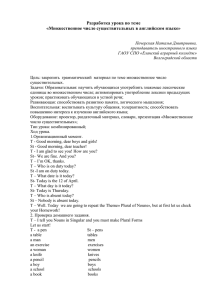
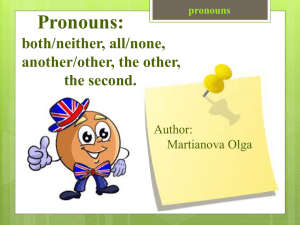
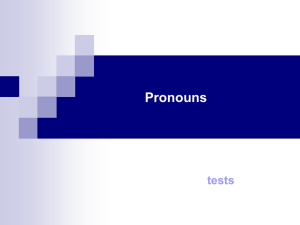
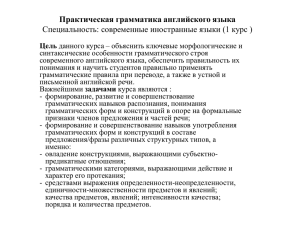
![[N[N]] - University of Oregon](http://s1.studylib.ru/store/data/005078930_1-91d3a60c2ee74894ae2e474f46cc8471-300x300.png)
